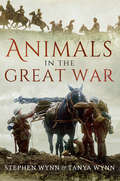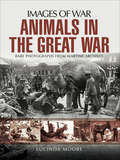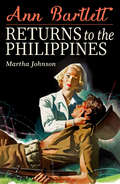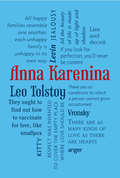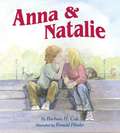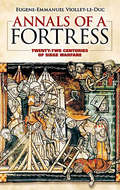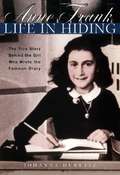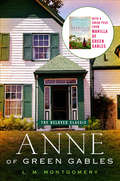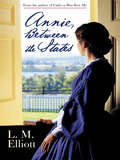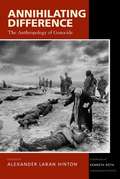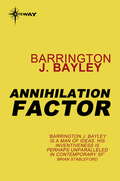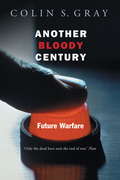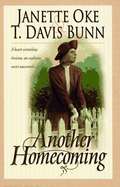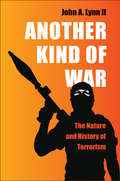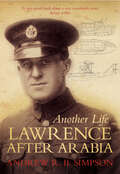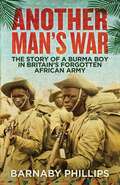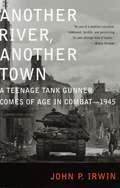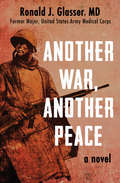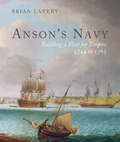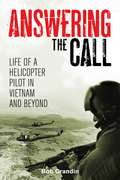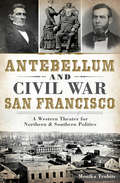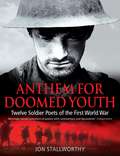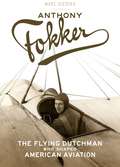- Table View
- List View
Animals in the Great War
by Stephen Wynn Tanya Wynn&“Cats, rabbits and even the bear that inspired Winnie the Pooh appear in remarkable photos of the 16 million animals caught up in World War One.&” —DailyMail.com Animals in the Great War looks at the use of animals by all sides in the Great War and to what effect. In the main, it focuses greatly on horses, dogs and pigeons but also addresses the war efforts of other animals. In the early years of the war horses were, to a large extent, the only form of transport that was available to the British Army, ranging from use by cavalry units, artillery units as well others such as the Army Ordnance Corps for the conveying of ammunition supplies to men fighting at the front. Britain sent an estimated one million horses to fight in the war, most of them to France and Belgium, but only 60,000 of them ever returned home, and only then were they returned because of the intervention of Winston Churchill. Dogs also played a major role in the war, especially in the trenches on the Western Front. They were used as mascots by the different regiments and in some cases, they were companions for homesick soldiers. They were also used for sentry duties in the trenches as well as catching rats, and they were used as messengers and to sniff out wounded soldiers in No Man&’s Land. Animals in the Great War explores how everyday domestic animals were transformed into remarkable wartime heroes, who more than did their bit for the war effort.
Animals in the Great War (Images of War)
by Lucinda MooreTails from the Great War throws a spot light on the experience of creatures great and small during the First World War, vividly telling their stories through the incredible archival images of the Mary Evans Picture Library. The enduring public interest in Michael Morpurgos tale of the war horse reveals an enthusiasm for the animal perspective on war, but what of the untold stories of the war dog, the trench rat or even the ships pig? Through unrivaled access to rarely seen illustrated wartime magazines, books and postcards, discover the sea lions who were trained to detect submarines, and witness the carcass of the 61ft mine-destroying wonder whale. Meet the dog that brought a sailor back from the brink of death, and inspired a Hollywood legend. See how depictions of animals were powerfully manipulated by the propaganda machine on both sides, and how the presence of animals could bring much needed and even lifesaving companionship and cheer amid the carnage of war. As the centenary of the Great War is commemorated all over the world, take a timely journey via the lens of Mary Evans wartime images, and marvel at the often overlooked but significant contribution and experience of animals at war. By turns astonishing, heart-warming and occasionally downright bizarre, Tails from the Great War champions the little-known story of the bison, the chameleon, the canary et al in wartime.
Ann Bartlett Returns to the Philippines
by Martha JohnsonAnn Bartlett Returns to the Philippines, first published in 1945, is an exciting historical-fiction novel centering on Navy nurse Ann Bartlett and her friend and fellow nurse Evelyn Baldwin; location: the occupied Philippines during World War II. The pair travel from the U.S. to the Philippines and serve as nurses aboard a ship. Upon reaching the Philippines, their adventures begin as Ann boards a lifeboat searching for survivors of a nearby ship that has gone down following a Japanese attack; foggy weather separates the lifeboat from the ship, and when the weather clears, a Japanese airplane machine-guns the boat, forcing the passengers into the water. The story continues with the survivors reaching an island shore, narrow escapes from the Japanese, and a romance. Five ‘Ann Bartlett’ books were published by author Martha Johnson between 1941-1946.
Anna Karenina (Word Cloud Classics)
by Leo TolstoyThe nineteenth-century Russian classic novel of a tumultuous love affair set amidst the nation&’s changing society in the 1870s. First published in the late nineteenth century, Anna Karenina, by famed Russian writer Leo Tolstoy, is widely regarded as one of the greatest novels of all time. Chronicling the turbulent affair between Anna Karenina and Count Vronsky, Tolstoy weaves a parallel plot of self-discovery and a turn to religion by character Konstantin Levin that is thought to be autobiographical. The result is a tale of jealousy, faith, hypocrisy, passion and progress set amidst the social change occurring in Russia in the 1870s. Now available as part of the Word Cloud Classics series, the novel is a must-have addition to the libraries of all classic literature lovers. &“One of the greatest love stories in world literature.&” —Vladimir Nabokov
Anna and Natalie
by Barbara H. ColeAnna is never picked to be on any team at school. But she is determined to be chosen when Mrs. Randall announces a letter-writing contest to decide which four students will be part of the wreath-laying team at the Tomb of the Unknown Soldier in Arlington, Virginia. This moving story of how Anna deals with her disability will touch the hearts of all readers as they cheer her on to the surprise ending.
Annals of a Fortress: Twenty-two Centuries of Siege Warfare
by Eugene-Emmanuel Viollet-le-Duc Benjamin BucknallCombining the excitement of a novel with the authenticity of a historical document, this gripping book chronicles a castle's rise from obscurity to international attention during the nineteenth century. It profiles a fictional fortress, La Roche-Pont, for an unusual survey of the evolving art of siege warfare--from Gallic tribes attempting to hold off the might of the Roman empire through medieval feuds, protracted religious conflicts of the seventeenth century, and the Napoleonic and Franco-Prussian Wars.The noted architect Eugene-Emmanuel Viollet-le-Duc (1814-1879) was in a unique position to write this book. A central figure in France's Gothic Revival, Viollet-le-Duc had a second career in the military that included a prominent role in the defense of Paris during the Franco-Prussian War of the 1870s. With this accessible, well-researched study, he exerted an enduring influence on French military defensive thinking. Subtle and enchanting in its blend of fact and fiction, Annals of a Fortress continues to offer a brilliant evocation of more than 2,000 years of European warfare.
Anne Frank: Life in Hiding
by Johanna HurwitzIn this sensitive introduction to the Holocaust and to the life of the little girl who hid out and kept a diary during World War II, this acclaimed author deftly evokes the background of the war while capturing the girl's unforgettable spirit.
Anne of Green Gables (Anne Of Green Gables Ser. #1)
by L. M. MontgomeryThe beloved classic story from L.M. Montgomery of the orphan who captured readers’ hearts around the world—now includes an excerpt from Sarah McCoy’s novel Marilla of Green Gables—a bold, heartfelt tale of life at Green Gables . . . before Anne.Marilla and Mathew Cuthbert had planned to adopt a boy to help out around Green Gables farm. But waiting for Mathew at the train station is freckle-faced, red-headed Anne Shirley—a talkative eleven-year-old orphan with a heart full of dreams and a desperate longing for a home.From the moment Anne arrives, Green Gables will be transformed forever.
Annie, Between the States
by L. M. ElliottAnnie's home and heart are divided by the Civil War. Annie Sinclair's Virginia home is in the battle path of the Civil War. Her brothers, Laurence and Jamie, fight to defend the South, while Annie and her mother tend to wounded soldiers. When she develops a romantic connection with a Union Army lieutenant, Annie's view of the war broadens. Then an accusation calls her loyalty into question. A nation and a heart divided force Annie to choose her own course.
Annie, Between the States
by L. M. ElliottAnnie's home and heart are divided by the Civil War.Annie Sinclair's Virginia home is in the battle path of the Civil War. <P><P> Her brothers, Laurence and Jamie, fight to defend the South, while Annie and her mother tend to wounded soldiers. <P><P>When she develops a romantic connection with a Union Army lieutenant, Annie's view of the war broadens. <P>Then an accusation calls her loyalty into question. A nation and a heart divided force Annie to choose her own course.
Annihilating Difference: The Anthropology of Genocide
by Alexander Laban HintonThis collection of original essays on genocide explores a wide range of cases, including Nazi Germany, Cambodia, Guatemala, Rwanda, and Bosnia.
Annihilation Factor
by Barrington J. BayleyFrom the Garlowe Clusters in the north to the Veils of Darkness in the south, the Star Kingdom sprawled over roughly a fifth of the galaxy. So huge was this realm that those who tussled for power over it seemed unable to appreciate that it faced annihilation by the Patch, a roving region of peculiar pseudo-energy a light-year across which drained the life-force from any living thing it encountered.The Patch had moved into the Kingdom and was systematically feeding on system after system. Cynically unperturbed by the appalling loss of life, the royal houses merely tried to involve the Patch in their machinations, to the extent that civil war broke out all over again. But in the event, the Patch was to provide the crucial factor in the struggle for absolute power. The Annihilation Factor!
Another Bloody Century: Future Warfare
by Colin S. GrayHow the wars of the near future will be fought and who will win themMany nations, peoples and special interest groups believe that violence will advance their cause. Warfare has changed greatly since the Second World War; it continued to change during the late 20th century and this process is still accelerating. Political, technological, social and religious forces are shaping the future of warfare, but most western armed forces have yet to evolve significantly from the cold war era when they trained to resist a conventional invasion by the Warsaw Pact. America is now the only superpower, but its dominance is threatened by internal and external factors. The world's most hi-tech weaponry seems helpless in the face of determined guerrilla fighters not afraid to die for their beliefs.Professor Colin Gray has advised governments on both sides of the Atlantic and in ANOTHER BLOODY CENTURY, he reveals what sort of conflicts will affect our world in the years to come.
Another Bloody Century: Future Warfare
by Colin S. GrayHow the wars of the near future will be fought and who will win themMany nations, peoples and special interest groups believe that violence will advance their cause. Warfare has changed greatly since the Second World War; it continued to change during the late 20th century and this process is still accelerating. Political, technological, social and religious forces are shaping the future of warfare, but most western armed forces have yet to evolve significantly from the cold war era when they trained to resist a conventional invasion by the Warsaw Pact. America is now the only superpower, but its dominance is threatened by internal and external factors. The world's most hi-tech weaponry seems helpless in the face of determined guerrilla fighters not afraid to die for their beliefs.Professor Colin Gray has advised governments on both sides of the Atlantic and in ANOTHER BLOODY CENTURY, he reveals what sort of conflicts will affect our world in the years to come.
Another Homecoming
by Janette Oke Davis BunnDuring World War II Martha faces difficult decisions when her husband is reported missing in action. THE WORLD IS AT WAR. A young man bravely kisses his weeping bride goodbye at the train station, leaving her all alone. Then the dreaded telegram, and a decision that nearly tears her apart... A LITTLE GIRL GROWS into young womanhood, unaware of the forces that swirl around her past and her future. WILL THERE BE... Another Homecoming
Another Kind of War: The Nature and History of Terrorism
by John A. LynnAn accessible and comprehensive history of terrorism from ancient times to the present In the years since 9/11, there has been a massive surge in interest surrounding the study of terrorism. This volume applies distinguished military historian John Lynn’s lifetime of research and teaching experience to this difficult topic. As a form of violence that implies the threat of future violence, terrorism breeds insecurity, vulnerability, and a desire for retribution that has far-reaching consequences. Lynn distinguishes between the paralyzing effect of fear and the potentially dangerous and chaotic effects of moral outrage and righteous retaliation guiding counterterrorism efforts. In this accessible and comprehensive text, Lynn traces the evolution of terrorism over time, exposing its constants and contrasts. In doing so, he contextualizes this violence and argues that a knowledge of the history and nature of terrorism can temper its psychological effects, and can help us more accurately and carefully assess threats as well as develop informed and measured responses.
Another Life: Lawrence After Arabia
by Andrew R B SimpsonT.E. Lawrence found global recognition for his leadership of the Arab Revolt during World War I, preparing the ground for the final Allied offensive in 1918. He was hailed as a hero, but little is known about this mysterious and charismatic man after those events. Here is Lawrence’s life after Arabia, his service in the RAF and the Tank Corps as a mere ranker, and how he became an expert in the technology of the new RAF. The book examines the work he did for the 1929 Schneider Trophy Race, the development of the new RAF 200 seaplane tender, and the development of its armour plated offspring, the Armoured Target Boat. It also investigates his literary endeavours and his tragically early death, a sad end to a Renaissance man of all talents, an academic, a talented engineer and a soldier sans pareil. T.E. was offered exalted diplomatic positions by Churchill, implored by Nancy Astor to re-enter the fray as the Nazi threat grew, socialised with the Cliveden set, argued with the Archbishop of Canterbury. He made lasting friendships with humble squaddies. His self-loathing was expressed physically. Consulting primary sources and also having interviewed some of those who knew Lawrence after Arabia the author portrays the last years of one of the most astonishing figures of the 20th century.
Another Man's War: The Story Of A Burma Boy In Britain's Forgotten Army
by Barnaby PhillipsIn December 1941 the Japanese invaded Burma. For the British, the longest land campaign of the Second World War had begun. 100,000 African soldiers were taken from Britain’s colonies to fight the Japanese in the Burmese jungles. They performed heroically in one of the most brutal theatres of war, yet their contribution has been largely ignored. Isaac Fadoyebo was one of those 'Burma Boys’. At the age of sixteen he ran away from his Nigerian village to join the British Army. Sent to Burma, he was attacked and left for dead in the jungle by the Japanese. Sheltered by courageous local rice farmers, Isaac spent nine months in hiding before his eventual rescue. He returned to Nigeria a hero, but his story was soon forgotten. Barnaby Phillips travelled to Nigeria and Burma in search of Isaac, the family who saved his life, and the legacy of an Empire. Another Man’s War is Isaac’s story.
Another River, Another Town: A Teenage Tank Gunner Comes of Age in Combat--1945
by John P. IrwinMany narrative accounts of men in combat during World War II have conveyed the horrors and emotions of warfare. However, not many reveal in such an intimate way the struggle of innocent youth to adapt to the primitive code of "kill or be killed," to transform from lads into combat soldiers. Another River, Another Town is the story of John P. Irwin, a teenage tank gunner whose idealistic desire to achieve heroism is shattered by the incredibly different view of life the world of combat demands. He comes to the realization that the realm of warfare has almost nothing in common with the civilian life from which he has come. The interminable fighting, dirt, fatigue, and hunger make the war seem endless. In addition to the killing and destruction on the battlefield, Irwin and his crew are caught up in the unbelievable depravity they encounter at Nordhausen Camp, where slave laborers are compelled to work themselves to death manufacturing the infamous V-rockets that have been causing so much destruction in London, and that are expected one day to devastate Washington, D.C. At the end of the war, the sense of victory is, for these men, overshadowed by the intense joy and relief they experience in knowing that the fighting is at last over.From the Hardcover edition.
Another War, Another Peace: A Novel
by Ronald J. GlasserThe powerful story of an unlikely friendship and a doctor&’s re-education on the battlefields of the Vietnam WarFresh out of medical school and planning to enter academia, David pragmatically applies to serve in the US Army, thinking he would rather work in a stateside military hospital than get drafted. But when he gets reassigned to Southeast Asia, he suddenly finds himself on a base in Vietnam. He joins a civilian aid mission on a supposedly secure plateau, and spends his days dispensing pills to villagers. As David comes to terms with the unexpected factors that brought him to Vietnam, he must adjust to many more twists and turns—among them his relationship with his driver, Tom, a young, rough-hewn Southerner whose reticence feels unnervingly like indifference. Gradually, however, David sees that there&’s far more to Tom than he initially thought. As their friendship grows, David also realizes that his fellow doctors and the troops on base hold widely diverging opinions about the war and its objectives. As it becomes clear that their base is located on a key strategic route—the notorious Ho Chi Minh Trail—and thus a vulnerable target, it&’s only a matter of time before battles break out . . .
Anson's Navy: Building a Fleet for Empire 1744–1763
by Brian LaveryDespite a supreme belief in itself, the Royal Navy of the early eighteenth century was becoming over-confident and outdated, and it had more than its share of disasters and miscarriages including the devastating sickness in Admiral Hosier’s fleet in 1727; failure at Cartagena, and an embarrassing action off Toulon in 1744\. Anson’s great circumnavigation, though presented as a triumph, was achieved at huge cost in ships and lives. And in 1756 Admiral Byng was shot after failure off Minorca. In this new book, the bestselling author Brian Lavery shows how, through reforms and the determined focus of a number of personalities, that navy was transformed in the middle years of the eighteenth century. The tide had already begun to turn with victories off Cape Finisterre in 1747, and in 1759 the navy played a vital part in the ‘year of victories’ with triumphs at Lagos and Quiberon Bay; and it conducted amphibious operations as far afield as Cuba and the Philippines, and took Quebec. The author explains how it was fundamentally transformed from the amateurish, corrupt and complacent force of the previous decades. He describes how it acquired uniforms and a definite rank structure for officers; and developed new ship types such as the 74 and the frigate. It instigated a more efficient (if equally brutal) method of recruiting seamen, and boosted morale and motivation and a far more aggressive style of fighting. The coppering of ships’ hulls and the solving of the problems associated with longitude and scurvy, were also hugely significant steps. Much of this transformation was due to the forceful if enigmatic personality of George, Lord Anson. In a largely static society, he changed the navy so that it was fit for purpose, and in readiness for Nelson just decades later. Using a mass of archival evidence and a mix of official reports and personal reminiscences, this book offers a fascinating and engrossing analysis of all these far-reaching reforms, which in turn led to the radical transformation of Britain’s navy into a truly global force. The consequential effect on the world’s history would be huge.
Answering the Call: Life of a Helicopter Pilot in Vietnam
by Bob GrandinIn 1966, Bob Grandin was a Royal Australian Airforce helicopter pilot stationed in Vietnam. This book is written from the logbook he kept while working in Nui Dat and is a fascinating look at life during war – the dangers, the challenges and the mundaneness. On 18 August he was co-pilot on a 9 Squadron Iroquois &‘Huey&’ helicopter that flew over the enemy to resupply desperate solders engaged in battle at the Long Tan rubber plantation. Enduring extremely poor weather conditions and enemy fire the critical role played by Bob and 9 Squadron in the Battle of Long Tan contributed to the success of this battle. The narrative of his war experiences are interwoven with stories of his life after Vietnam, revealing the difficulties he faced back home, the impact of the war on his psyche and relationships, and his struggles with PTSD. A collection of Australian newspaper articles saved by Bob&’s father feature throughout, giving further insight into how important helicopters were in Vietnam, and also how the press reported the war to the Australian public. Answering the Call provides the unique perspective of a wartime helicopter pilot and is an important addition to Vietnam War history.
Antebellum and Civil War San Francisco: A Western Theater for Northern & Southern Politics (Civil War Ser.)
by Monika TrobitsWhen Americans migrated westward, they took their politics with them, making San Francisco a microcosm of the nation as the Civil War loomed. Spurred by the promise of gold, hungry adventurers flocked to San Francisco in search of opportunity on the eve of the Civil War. The city flourished and became a magnet for theater. Some of the first buildings constructed in San Francisco were theater houses, and John Wilkes Booth&’s famous acting family often graced the city&’s stages. In just two years, San Francisco&’s population skyrocketed from eight hundred to thirty thousand, making it an &“instant city&” where tensions between transplanted Northerners and Southerners built as war threatened the nation. Though seemingly isolated, San Franciscans took their part in the conflict. Some extended the Underground Railroad to their city, while others joined the Confederate-aiding Knights of the Golden Circle. Including a directory of local historic sites and streets, author Monika Trobits chronicles the dramatic and volatile antebellum and Civil War history of the City by the Bay. Includes photos
Anthem for Doomed Youth: Twelve Soldier Poets of the First World War
by Prof Jon StallworthyLeading poet and former professor of English Literature, Jon Stallworthy, tells the story of the lives and work of twelve major poets of the First World War and provides selections of their best work. The First World War began with flag-waving, parades and poets inspired by abstract ideals. In part this reflected the national mood , but it revealed an almost universal failure to understand what modern mass warfare would really mean. The story of the 'war poets' is also the story of an awakening to the full horror of what the twentieth century came to know as 'The Great War'.Wilfred Owen said, 'My subject is War - and the pity of War'. He also said 'true Poets must be truthful'. The best war poetry was the work of writers who were also serving soldiers and was born out of their desire to tell the truth about what it was to be a soldier in the trenches - what it felt like, what it did to you and what it did to your fellow soldiers, friend or foe. The greatness of the poetry lay not just in the writer's talent, but in the unflinching accuracy with which it portrayed their terrible circumstances.
Anthony Fokker: The Flying Dutchman Who Shaped American Aviation
by Marc DierikxComprehensive biography of Anthony Fokker, the famed Dutch pilot and daredevil aviatorAnthony Fokker: The Flying Dutchman Who Shaped American Aviation tells the larger-than-life true story of maverick pilot and aircraft manufacturer Anthony Fokker. Fokker came from an affluent Dutch family and developed a gift for tinkering with mechanics. Despite not receiving a traditional education, he stumbled his way into aviation as a young stunt pilot in Germany in 1910. He survived a series of spectacular airplane crashes and rose to fame within a few years. A combination of industrial espionage, luck, and deception then propelled him to become Germany's leading aircraft manufacturer during World War I, making him a multimillionaire by his midtwenties.When the German Revolution swept the country in 1918 and 1919, Fokker made a spectacular escape to the United States. He set up business in New York and New Jersey in 1921, and shortly thereafter became the world's largest aircraft manufacturer. The U.S. Army and Navy acquired his machines, and his factories equipped legendary carriers such as Pan American and TWA at the dawn of commercial air transport.Yet despite his astounding success, his empire collapsed in the late 1920s after a series of ill-conceived business decisions and deeply upsetting personal dramas. In 1927, aviator Richard Byrd solicited a Fokker three-engine plane to be the first to fly non-stop across the Atlantic. The plane was damaged on a test flight and Charles Lindbergh beat him to it. Lindbergh's solo adventure in the Spirit of St. Louis earned him--and cost Fokker--a lasting place in the history books. Using previously undiscovered records and primary sources, Marc Dierikx traces Fokker's extraordinary life and celebrates his spectacular achievements.
